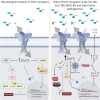The P2X7 Receptor: Central Hub of Brain Diseases
- PMID: 32848594
- PMCID: PMC7413029
- DOI: 10.3389/fnmol.2020.00124
The P2X7 Receptor: Central Hub of Brain Diseases
Abstract
The P2X7 receptor is a cation channel activated by high concentrations of adenosine triphosphate (ATP). Upon long-term activation, it complexes with membrane proteins forming a wide pore that leads to cell death and increased release of ATP into the extracellular milieu. The P2X7 receptor is widely expressed in the CNS, such as frontal cortex, hippocampus, amygdala and striatum, regions involved in neurodegenerative diseases and psychiatric disorders. Despite P2X7 receptor functions in glial cells have been extensively studied, the existence and roles of this receptor in neurons are still controversially discussed. Regardless, P2X7 receptors mediate several processes observed in neuropsychiatric disorders and brain tumors, such as activation of neuroinflammatory response, stimulation of glutamate release and neuroplasticity impairment. Moreover, P2X7 receptor gene polymorphisms have been associated to depression, and isoforms of P2X7 receptors are implicated in neuropsychiatric diseases. In view of that, the P2X7 receptor has been proposed to be a potential target for therapeutic intervention in brain diseases. This review discusses the molecular mechanisms underlying P2X7 receptor-mediated signaling in neurodegenerative diseases, psychiatric disorders, and brain tumors. In addition, it highlights the recent advances in the development of P2X7 receptor antagonists that are able of penetrating the central nervous system.
Keywords: P2X7 receptor; P2X7 receptor antagonists; brain diseases; brain tumor; neurodegenerative diseases; psychiatric disorders.
Copyright © 2020 Andrejew, Oliveira-Giacomelli, Ribeiro, Glaser, Arnaud-Sampaio, Lameu and Ulrich.
Figures



References
-
- Ali Z., Laurijssens B., Ostenfeld T., Mchugh S., Stylianou A., Scott-Stevens P., et al. (2013). Pharmacokinetic and pharmacodynamic profiling of a P2X7 receptor allosteric modulator GSK1482160 in healthy human subjects. Br. J. Clin. Pharmacol. 75 197–207. 10.1111/j.1365-2125.2012.04320.x - DOI - PMC - PubMed
Publication types
LinkOut - more resources
Full Text Sources
Other Literature Sources

